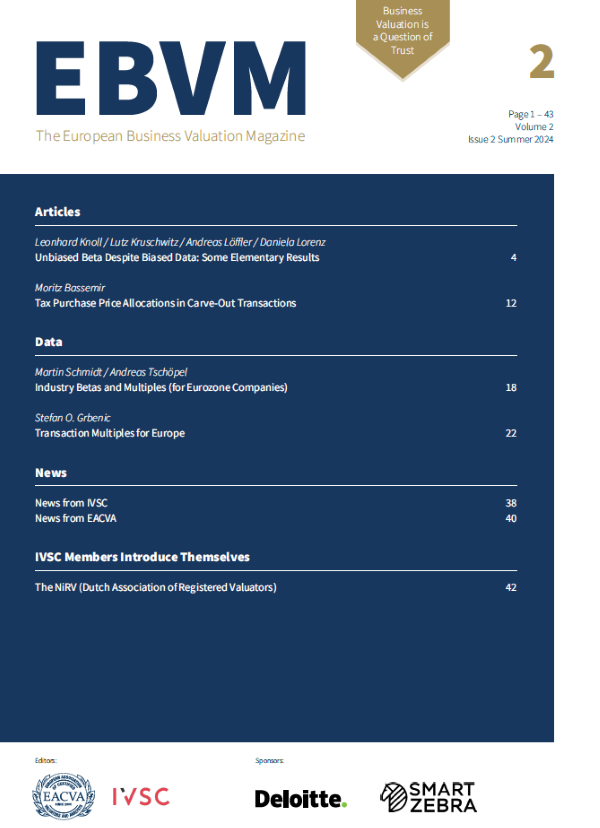European Business Valuation Magazine
Issue Summer 2024

The European Association of Certified Valuators and Analysts (EACVA) and the International Valuation Standards Council (IVSC) are pleased to present the 8th issue of the new European Business Valuation Magazine (EBVM), published in July 2024.
- Editorial: The Impact of Artificial Intelligence on Business Valuations – Points of Reflection
Ascanio Salvidio, ACA, FRICS - Unbiased Beta Despite Biased Data: Some Elementary Results
Prof. Dr. Leonhard Knoll / Prof. Dr. Dr. h.c. Lutz Kruschwitz / Prof. Dr. Dr. Andreas Löffler / Prof. Dr. Daniela Lorenz - Tax Purchase Price Allocations in Carve-Out Transactions
Dr. Moritz Bassemir - Data: Industry Betas and Multiples (for Eurozone Companies)
Dr. Martin H. Schmidt | Dr. Andreas Tschöpel, CVA, CEFA, CIIA - Data: Transaction Multiples (Europe)
Prof. Dr. Stefan O. Grbenic, StB, CVA - News from IVSC
- News from EACVA
- IVSC Members Introduce Themselves:
The NiRV (Dutch Association of Registered Valuators)
Abstracts
This brief reflection on the impact of Artificial Intelligence (AI) on business valuations will focus on the valuation of unquoted entities. I believe that the use of the tools offered by AI will bring very significant changes to the business valuation profession. These developments will occur in a relatively short time and will be articulated in two phases. First phase – generation of valuation metrics based on the implementation of machine learning algorithms and initial automated or semi-automated valuation processes. The first attempts in this direction are already underway and stem from the possibility of “predicting” the current capitalization of a listed company with good accuracy, starting from a set of publicly available standardized data (Koklev, 2022), to then infer usable parameters, possibly after appropriate adjustments, for valuing unlisted companies (Jagrič, Fister, Grbenic, Herman, 2024). The quality of the predictions may be improved by training the algorithms on datasets selected by industry, geographic area, and reference sample size. Second phase – development of integrated valuation models, combining metrics and predictions generated by machine learning with the collection, analysis, and synthesis of unstructured information performed by large language models.
The availability of reliable business valuations, carried out in a very short time and at very low cost, will radically change the circulation of securities and rights representing the capital of unlisted companies and businesses, as well as the rights representing business units and intangible assets.
There are two possible contrasting scenarios that could have consequences for business valuers: The first, pessimistic, foresees the exit from the market of a significant part of the professionals currently involved in business valuations, consequently not so much of the automation of valuation processes, but of the sharp reduction in prices to the final customer. The activity of the professionals who will remain on the scene will consist of monitoring and continuously improving the valuation processes, as well as intervening in pathological cases, where personal expertise will always remain an essential element (for example, in the case of judicial disputes, fraud, etc.). The second, optimistic, is related to the many professional opportunities arising from the capital market benefits of AI-based valuation applications. It is reasonable to assume that as valuations multiply, there will be a greater demand for professional skills to critically understand the results and derive insights to improve corporate performance and business strategies. For valuation professionals, the current outlook suggests that the resulting challenges and opportunities should be addressed now.
We hope you enjoy reading the current EBVM issue and look forward to your feedback.
In many valuations, the cost of equity is determined on the basis of the CAPM. The dominating instrument for estimating the beta factor within this framework is the so-called Market Model. As far as the own beta of the valuation object is concerned, the reliability of the data available for this purpose is often questioned and an alternative tool, in particular a peer group beta, is used. The following article identifies types of data bias that do not affect the outcome of beta estimation – both for an individual company and for a peer group. The results urge caution against a hasty rejection of the object beta and an almost automatic use of peer group betas.
Corporates are increasingly using carve-outs for the divestment of non-core businesses in an attempt to streamline their organizational structure and to raise cash proceeds. Carveout transactions are usually executed on a local level with various share deals and asset deals requiring to allocate the (global) purchase price to the level of local legal entities / businesses and potentially even to the assets / liabilities (so called “tax PPA”). The purpose of this article is to show the steps and timing involved with a tax purchase price allocation (tax PPA). Overall, the paper shows that tax PPAs are a major factor affecting the financial and tax outcome of international carve-out transactions.
All data has been obtained from the KPMG Valuation Data Source. The data source provides access to cost of capital parameters from more than 150 countries and sectors as well as peer-group-specific data from over 16,500 companies worldwide. The data covers the period from 2012 to the present. The data is updated monthly and is accessible from anywhere around the clock. See KPMG Valuation Data Source for details.
The computations of the transaction multiples are based on the transaction and company data collected from various M&A databases, with the data being driven to consistency.
We publish transaction multiples for Europe and resulting regression parameters (including transactions of the period 1 April 2021 until 31 March 2024) for the following multiples:
- Deal Enterprise Value/Sales
- Deal Enterprise Value/EBITDA
- Deal Enterprise Value/EBIT
- Deal Enterprise Value/Invested Capital